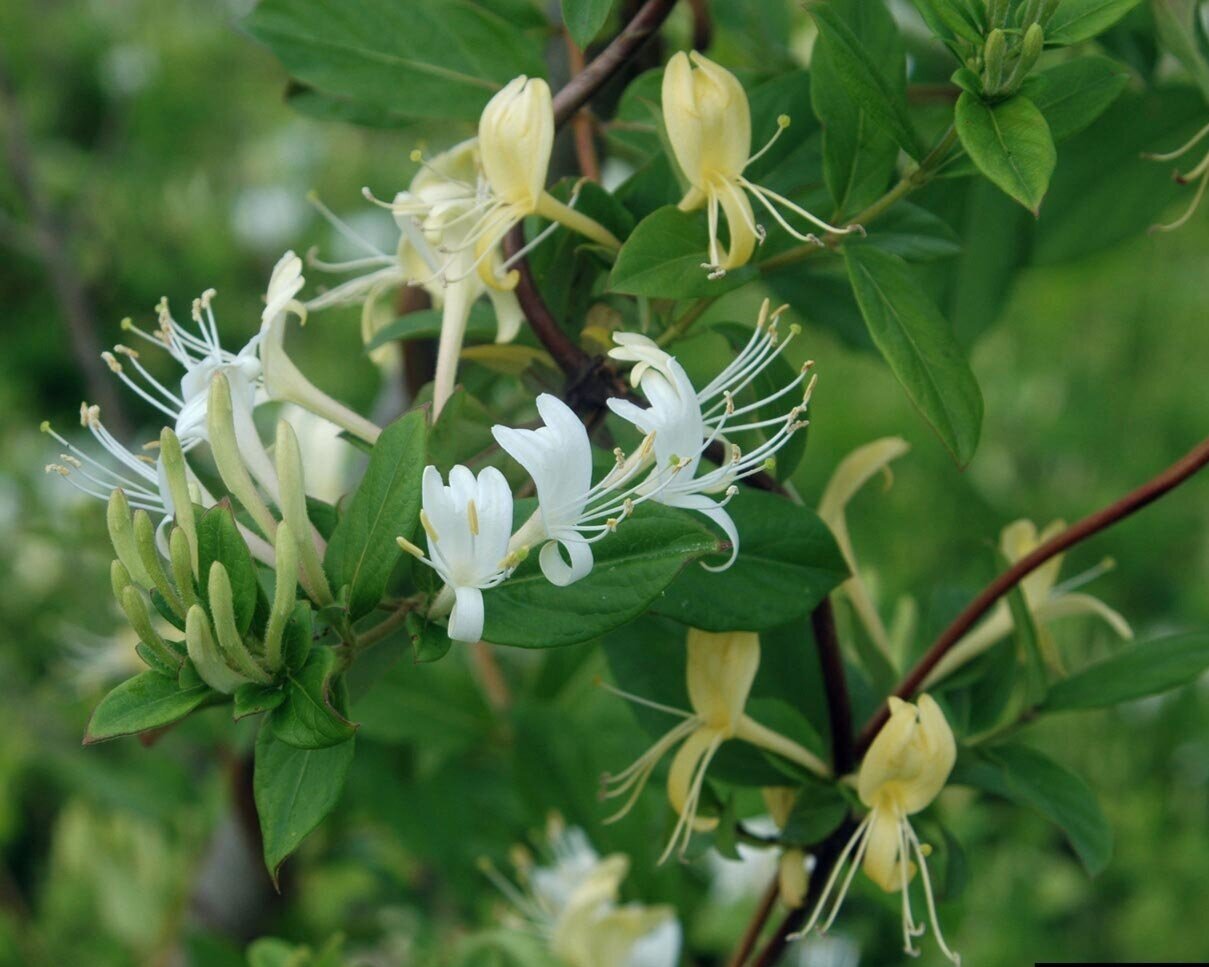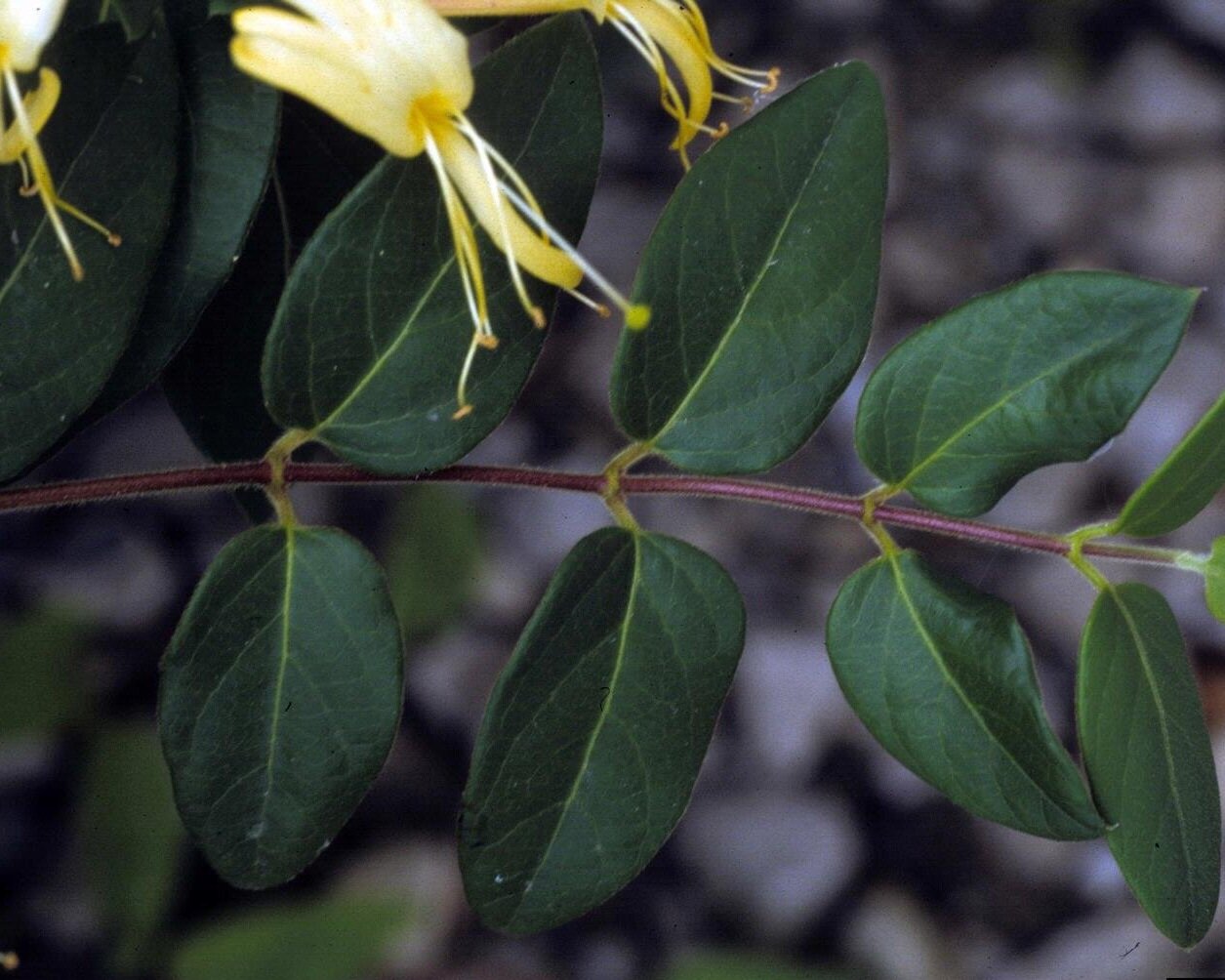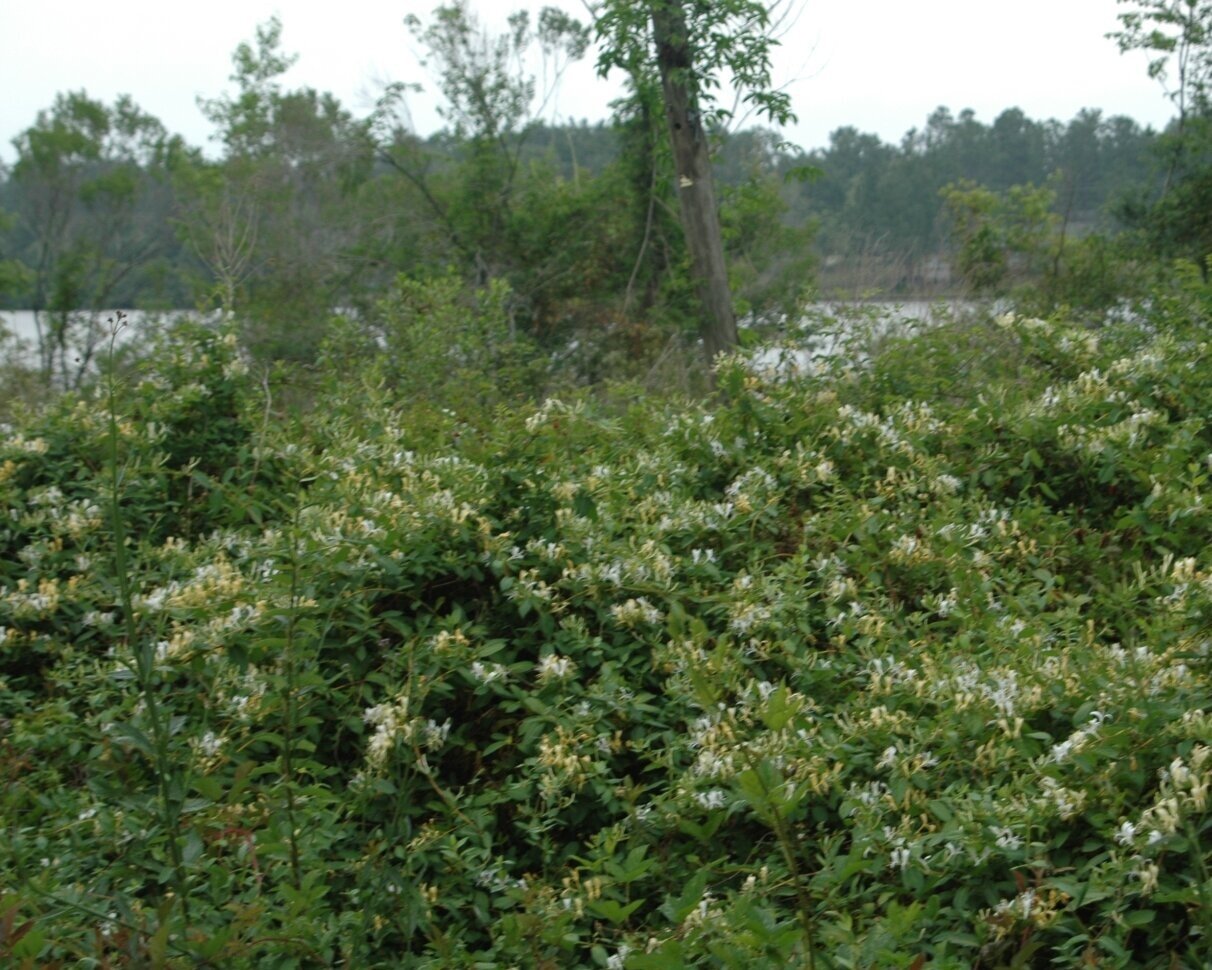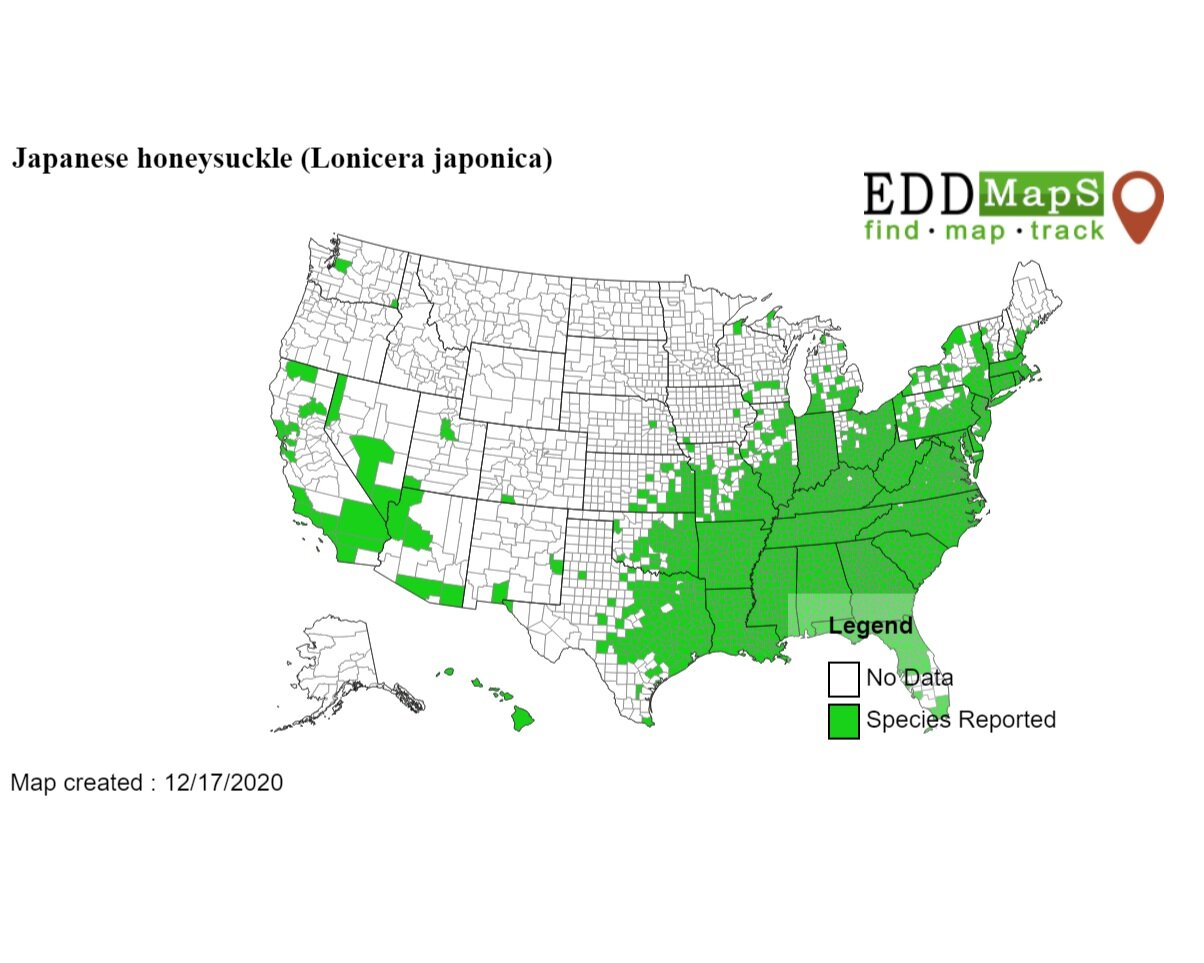February 2021 Invasive Plant of the Month
SICIM Email
Japanese Honeysuckle (Lonicera japonica)
Japanese Honeysuckle, also known Chinese honeysuckle, is a fast-growing, trailing or sprawling, semi-evergreen, perennial woody vine first introduced in Long Island, NY in 1806. It has been planted as an ornamental, for wildlife habitat and erosion control especially on farms. Assessed as a high rank invasive in Indiana by the Invasive Plant Advisory Committee (IPAC) and illegal under Indiana’s Terrestrial Plant Rule, it is still available for sale online and reportedly in some box stores typically as Hall’s Japanese Honeysuckle, (Lonicera japonica ‘Halliana’.)
IDENTIFICATION & BIOLOGY: Leaves are opposite, dark green, oblong, 1 ½ - 2" long, rounded at base, glabrous above and slightly hairy beneath. Usually ovate with entire margins. Bark is somewhat corky and peals easily on older stems. The stems/vines are reddish-brown, pubescent and twining; pith is excavated and eventually hollow. Buds are small, solitary and covered with two pubescent scales. Flowers are tubular, white or yellow, fragrant, and bloom May to mid-July. The fruit are berries and are smooth, blackish to slightly purplish 3 /16” to ¼” (6-7 mm) in diameter. Each berry contains 2-5 blackish ovate seeds. One side of the seed is ridged, while the other is flat. Rooting depth is generally 6” to 12” (15-30 cm) on moist sites, and up to 40” (102 cm) on dry sites. Roots may extend laterally to 8’ (2.4 m) from the crown. This vine spreads both vegetatively through runners and roots, as well as by seeds within the fruits. Birds and other wildlife readily consume the fruits and transport them to different areas.
LOOK-A-LIKES: Japanese honeysuckle is most often confused with our native vining honeysuckles which include red (Lonicera dioica), grape (L. reticulata), and trumpet honeysuckle (L. sempervirens). To differentiate, Japanese honeysuckle has purple/black berries and natives have red or orange berries. Their flowers are at the tips of stems whereas those of Japanese honeysuckle are in the leaf axils. The natives also have connate leaves (fused to form a single leaf with stem growing through it) below the flowers. Additionally, their leaf margins are always entire while Japanese honeysuckle leaves can be lobed. The leaves of Japanese honeysuckle often persist into winter.
HABITAT & DISTRIBUTION: Japanese honeysuckle prefers moist soils and full sun to partial shade but can tolerate full shade. It is an invader of forest floors, canopies, wetlands, floodplain woodlands, thickets, seeps, limestone glades, power-line clearances in woodland areas, semi-shaded areas, along roadsides and railroads, edges of yards and any disturbed areas. It occurs throughout the eastern half of the United States, an area encompassing 26 states as well as Ontario, Hawaii, Puerto Rico, and occasionally in the southwestern United States. Japanese honeysuckle’s range is limited to the north by severe winter temperatures and to the west by insufficient precipitation and prolonged droughts. It is in all 92 Indiana counties, but is much more aggressive in southern Indiana.
ECOLOGICAL THREAT: Japanese honeysuckle can girdle shrubs and small saplings by twining around them. It can form dense mats in open fields, on forest floors and in the canopies of trees, shading native vegetation. It excludes virtually all other vegetation and often inhibits forest regeneration. This, in turn, reduces biodiversity in these areas. These areas would otherwise host a diversity of native plants that in turn are host to native insects.
CONTROL:
Prevention – In order to reduce the spread of this invasive vine, stop the use of Japanese honeysuckle in ornamental landscape plantings and remove it from any existing intentional plantings. While illegal under the Terrestrial Plant Rule, Japanese honeysuckle is still available for purchase online.
Biological – None known.
Manual – Small populations can be controlled by hand-pulling and removal of vines. For best results, attempt this when soil is moist to maximize the amount of root removal. Mowing without being followed by a herbicide treatment and grazing are not recommended as mowing will limit the length of the vine but will increase the number of stems produced and hence the amount of fruit production!
Chemical – Application of glyphosate with a surfactant in late autumn when other vegetation is dormant but before a hard freeze (25 degrees F) when Japanese honeysuckle is still physiologically active has proven to be most effective. Triclopyr (broadleaf specific) with surfactant has shown positive results when used in the same manner. Earlier treatment is not recommended due to potential damage to non-target species which are crucial for recolonization of the treated area. Mechanical cutting of aerial vines followed by cut-surface herbicide treatment is also effective.
IMPORTANT: The pesticide label is the law! When using any chemical control, always read the entire pesticide label carefully, follow all mixing and application instructions and use all personal protective gear and clothing specified. Contact the Office of Indiana State Chemist (OISC) for additional pesticide use requirements, restrictions or recommendations.
Fire & Cultural – Japanese honeysuckle will survive fire by sprouting and rooting from stem tissue surviving within litter or upper soil layers. Specific information about postfire regeneration is lacking, but published sources indicate that in general, Japanese honeysuckle sprouts from root crowns and roots from trailing stems. However, prescribed burning can greatly decrease the abundance within a habitat and limit its spread for one to two growing seasons.
Maintenance – Initial control efforts should be monitored regularly over the course of multiple years such that continued chemical and/or cultural control of persistent or new infestations may be required.
JAPANESE HONEYSUCKLE HANDOUT:
https://www.invasive.org/weedcd/pdfs/wow/japanese_honeysuckle.pdf
JAPANESE HONEYSUCKLE REFERENCES & OTHER RESOURCES:
Dirr, M.A. (1990). Lonicera japonica. IN Manual of woody landscape plants: Their identification, ornamental characteristics, culture propagation and uses (p.579). Champaign, IL: Stipes.
https://www.dcnr.pa.gov/Conservation/WildPlants/InvasivePlants/Pages/default.aspx
https://nature.mdc.mo.gov/discover-nature/field-guide/japanese-honeysuckle
https://www.fs.fed.us/database/feis/plants/vine/lonjap/all.html
https://www.invasive.org/alien/pubs/midatlantic/loja.htm
https://www.invasivespeciesinfo.gov/
https://www.agriculture.nh.gov/publications-forms/documents/japanese-honeysuckle.pdf
https://www.entm.purdue.edu/iisc/pdf/plants/more/japanese_honeysuckle.pdf
https://www.mda.state.mn.us/japanese-honeysuckle
https://www.cabi.org/isc/datasheet/31191
LOOK-A-LIKE REFERENCES:
https://illinoiswildflowers.info/weeds/plants/jp_honeysuckle.htm
http://www.sicim.info/news/2020/4/18/tprandguide
https://www.nybg.org/
http://bioimages.vanderbilt.edu/pages/invasive-plants.htm#lonicera%20japonica
#japanesehoneysuckle #lonicerajaponica #indianainvasiveplants #indianainvasviesinitiative #invasiveplantofthemonth






